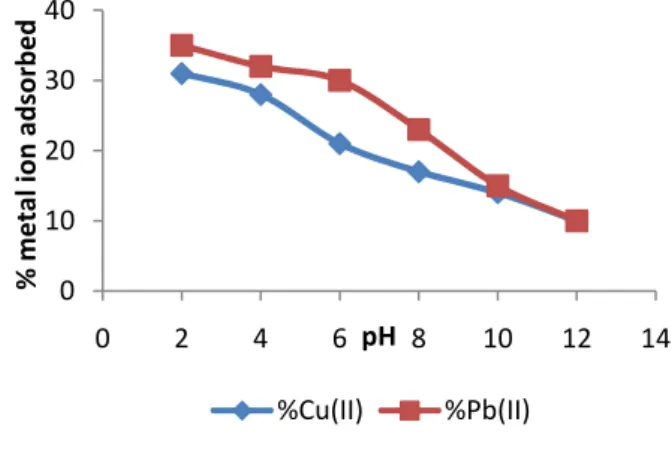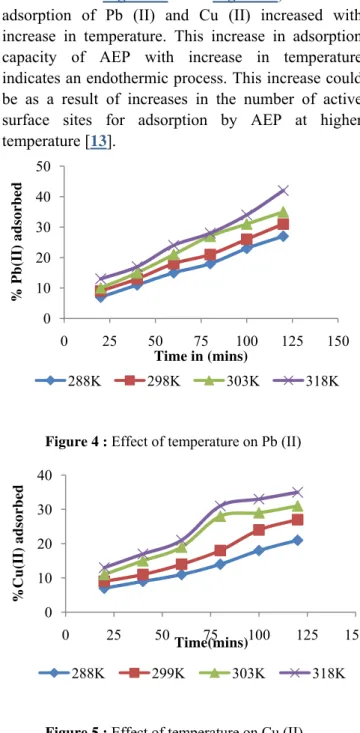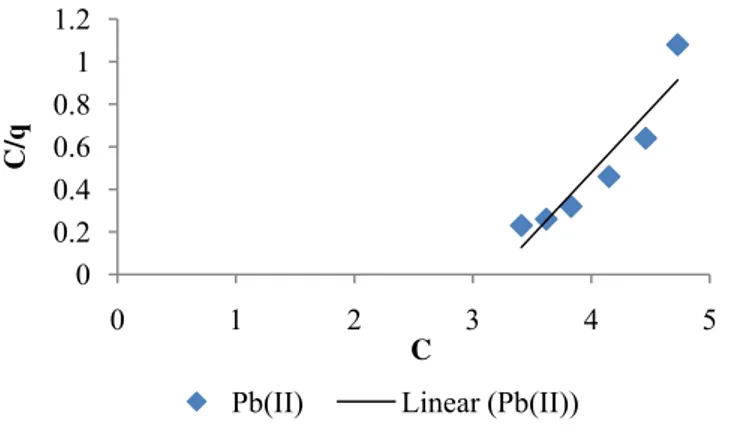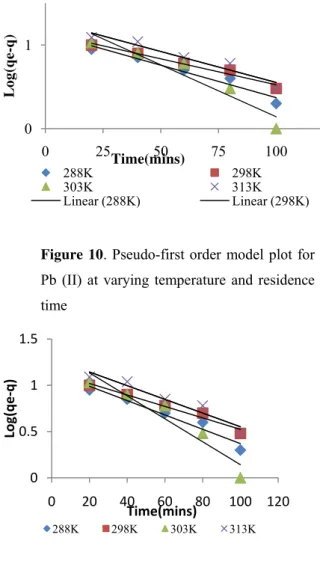Albanian j. agric. sci. 2013;12 (3): 353-359 Agricultural University of Tirana
Correspondence: H. I. Owamah, Civil Engineering Department, Landmark University, P.M.B.1001, Omu-Aran, Kwara State, Nigeria; Email: dahilla222@yahoo.com
(Accepted for publication 16 May 2013)
RESEARCH ARTICLE
(Open Access)
Evaluation of the adsorptive capacity of Activated
Egusi
Peels (AEP) for
the removal of heavy metals from aqueous solutions
I. H. OWAMAH1*., J. O. OJEDIRAN2 AND T. A. ADEKANYE3
1*
Civil Engineering Department, Landmark University, P.M.B.1001, Omu-Aran, Kwara State, Nigeria
2&3
Agricultural and Biosystems Engineering, Landmark University, Omu-Aran, Kwara State, Nigeria
Abstract
The removal of Pb (II) and Cu (II) by adsorption onto activated melon peels (AEP) adsorbent was investigated in this present paper. The adsorption data was well described by both the Langmuir and the Freundlich isotherm models. Adsorption was found to increase with increase in temperature, contact time and adsorbent dose but decreased with increase in pH. Pseudo-first order kinetic model was found suitable for describing the kinetics of the adsorption process. The Freundlich isotherm model kf was 3.43 for Pb (II) and 4.05 for Cu (II) signifying a preferential sorption for Cu (II) onto AEP in any industrial wastewater containing the two heavy metals. The Freundlich parameter n being less than unity indicates that the adsorption of Pb (II) and Cu (II) onto AEP was by physical sorption. Results from this study show that AEP could be used economically, for removing heavy metals from wastewater.
Keywords: Activated Egusi Peels (AEP), heavy metal adsorption, kinetic and isotherm study.
1. Introduction
Urbanization and industrialization have led to an increase in the amount of heavy metals in the environment. These heavy metals have been of great concern to both environmental scientists and environmental engineers, as a result of their negative effects on the environment; especially the receiving streams [1]. These heavy metals are toxic even at low concentrations. They are also non biodegradable and their presence in streams and lakes leads to bioaccumulation in living organisms which could lead to series of health problems to man.
The increased use of lead and copper for batteries and other applications, such as pigments, polyvinyl chloride stabilizers and plating, has led to a sharp global increase in the amount of lead and copper found in the environment [2]. Wood pulp production, paperboard mills and metal cleaning processes generate metal ions that are very toxic. It is therefore very necessary to treat such wastewater, before final disposal into the water bodies [2].
Lots of conventional methods like chemical precipitation, electrodialysis, reverse osmosis, adsorption by commercial activated carbon e.t.c. are used for removing heavy metals from wastewater but these technologies are quite expensive and not easily affordable by industries in developing nations. Again, industrial wastewater in many developing countries
undergoes little or no treatment before final discharge into receiving streams [3]. This could be attributed to the cost of treatment using high-tech methods and/or the non-availability of such technologies within the reach of the striving to survive industries. Alot of researchers have studied the use of low cost organic materials as substitutes for commercial activated carbon. Some of these studies are; adsorption of heavy metals from polluted water using activated carbon from date-pits [4], ferihydrite and leaf compost for wastewater treatment [5], kinetic and equilibrium modeling of nickel adsorption by modified cassava peels [6], [7] has reported on the potential use of rice straw as an adsorbent for removal of mercury ions at optimum pH range of 4-7.
Egusi (C. Lanatus) is a wild melon of the gourd
family that looks in appearance like a water melon. Though the flesh is not eatable, the seeds are a valuable source of food in Africa. The seeds contain nearly 50% edible oil and another 30% pure protein.
Egusi seeds are used for preparing various kinds of
food but majorly for cooking Egusi soup in West Africa, after peeling and grounding. These many uses
ofEgusi ,has led to the generation of large amount of
Egusi peels, which is normally burnt in the open or
used as fire starters in rural kitchens of developing countries. This disposal method is wasteful and impacts negatively on the climate.
and copper ions from wastewater. The adsorption kinetics and isotherms were also evaluated. The study also investigated the effect of varying temperature, pH and adsorbent dose on adsorption of lead and copper from aqueous solutions, using activated egusi peels inoder to determine the optimum conditions for the design for large scale adsorption columns that will utilize AEP for heavy metals removal. Results from this study will be useful in assessing the suitability of lead and copper ion removal from wastewater using AEP.
2. Materials and Method
2.1 Collection and preparation of the
adsorbent
Egusi peels were collected from the waste bin of
a middle class family in Ibusa, Oshimili North Local Government Area of Nigeria. These egusi peels were washed with deionized water and allowed to air-dry. This was followed by sun-drying for five days. The dried samples were ground using mechanical grinder and then sieved through a B.S. standard screen to obtain a particle size of 100μm and stored in a plastic container for further analysis.
2.2 Activation and purification of the biomass
It is often necessary to activate a solid before using it as an adsorbent for sorption studies. The purpose of activation is to increase the surface area of the solid by introducing a suitable degree of porosity into the solid matrix [8]. Again, activation may also produce structural defects in solids, which may be favorable to sorption processes [9]. The experiments on activation and purification of the biomasses were carried out according to the previous works of [9]. 500 g of finely divided biomass was activated and at the same time purified by soaking in excess 0.3 M HNO3 for 24 hours to remove any metals and debris that might be in the biomass prior to experimental metal ion exposure This was followed by washing thoroughly with deionized water until a pH of 7 ± 0.1 was attained and then air-dried. The air dried biomass was then washed with deionized water and re-suspended in 1.0M hydroxylamine to remove all O-acetyl groups. To remove all other soluble materials, the biomass was washed with deionized water.
2.4 Procedure for sorption and analysis
12 g of sorbent dose in metal solution were used for the experiment. 1000g stock solutions were prepared using copper nitrate and lead nitrate which were diluted with distilled water to prepare working solutions. Apart from the effect of pH and temperature experiments, all other experiments were carried out in the pH range of 2-2.2 and room temperature (27±30C). Agitation of the mixture was done by a rotary shaker at 160 rpm. The sample was allowed to settle for about 60 seconds following the end of the experiment. Thereafter the supernatant sample was analyzed for its Pb (II) and Cu (II) concentration, through the use of atomic absorption spectrophotometer. Isotherm sorption studies were carried out at adsorbent dose of 2g/l-12g/l while keeping the initial Pb (II) and Cu (II) concentrations constant at 5..20mg/l for Pb (II) and 4.20 mg/l for Cu (II) for the various experiments.
3. Existing Theory
3.1 Calculation of the degree of metal ion
removal
The amount of Pb(II) and Cu(II)removed by the biomass during the series of batch investigations were determined using a mass balance equation expressed as shown in Equation (1);
(
C C)
MV
q= 0 −
(1) where;
q = Fractional coverage of the surface (mg/g) C = Metal-concentration concentration (mg/l) at time t
C0 = Initial metal-ion concentration in solution
(mg/l)
V= Volume of solution (L) M= Mass of obvious used (g)
3.2 Calculation of metal ion removal
efficiency
The amount of sorbed Pb (II) and Cu (II) was expressed as sorption percent, %S [8]
100
%
0
0
−
×
=
C
C
C
S
(2)
Where C0 and C are as defined in Eq. (1)
3.3 Equilibrium isotherm
unit operation usually described by isotherm models whose parameters express the surface properties and affinity of the adsorbent. Two adsorption isotherm models were used to fit the experimental data. The Langmuir and the Freundlich isotherm models were carefully applied to study the adsorption of Pb (II) and Cu (II) onto the activated melon peels biomass.
C n K
q ln f 1ln
ln = +
3.3.1 The Langmuir Isotherm
The Langmuir isotherm model was chosen for the estimation of maximum adsorption capacity corresponding to complete monolayer coverage on the biomass surface. The Langmuir isotherm is expressed as shown in Equation (3)
C
K
C
K
q
q
m l+
=
1
l(3)
Where Kl=Langmuir isotherm constant (lg-1),
qm = Langmuir monolayer adsorption capacity
(mgg-1).Solving Equation(3), gives Equation(4):
m l
m K q
q C q
C = + 1
(4)
The experimental data were fit into Equation (4) by plotting C/q against C.
3.3.2 Favourability of Adsorption of Pb (II)
and Cu (II) onto AEP
The essential characteristics of the Langmuir isotherm can be described by a separation factor RL,
which is defined by [10], as shown in Equation (5)
0 1
1 C K R
L
L = +
(5)
where C0 = initial concentration of heavy metal
ion (mg/l) and KL is the Langmuir constant, which
indicates nature of adsorption. The separation factor RL indicates the isotherm shape and tells whether the
adsorption process is favourable or not.
3.3.3 Freundlich Isotherm Model
Freundlich model was also chosen to estimate the adsorption intensity of the adsorbate towards the adsorbent (biomass) and is represented by Equation (6) [10].
n
C
K
q
1
=
f(6)
where q= fractional coverage of the surface (mg/mg), C= the amount of metal ion concentration at time t in (mg/l); Kf and n are the Freundlich constants.
Taking the natural logarithm of both sides of Equation (6), we have
(7)
A plot of lnq against lnC that yields a straight line indicates the confirmation of the Freundlich adsorption isotherm model. The constants 1/n and lnKfcan be determined from the slope and intercept of
plot [11].
3.4 Kinetics of sorption
The kinetics of sorption is one of the most
important factors for predicting the rate at which sorption takes place for a given system and also it is very essential in understanding adsorption system design with a given adsorption residence time and reactor mechanism. However, sorption kinetics shows a large dependence on the physical and/or chemical characteristics of the adsorbent material which also influences the sorption process and mechanism [12]. The linear form of pseudo first order kinetic model can be expressed as shown in Eq. (8):
(
q
mq
)
ln
q
mK
1t
ln
−
=
−
(8)
where qm= maximum adsorption capacity and is
equal to qe (adsorption capacity at equilibrium) in
mg/g), q is the adsorption capacity(mg/g) at any time t(h), K1 is the pseudo first order rate constant(h-1)
4. Results and Discussion
4.1 Effect of varying pH
As shown in Figure 1, the percentage amount of lead and copper ions adsorbed decreased with increase in pH. This suggests that the adsorption of Pb (II) and Cu (II) from wastewater using activated melon peels as bio-sorbent is better in acidic medium.
0 10 20 30 40
0 2 4 6 8 10 12 14
%
metal
ion
adsorbed
pH
%Cu(II) %Pb(II)
Figure 1: Effect of pH on Pb (II) and Cu (II) adsorption
4.2 Effect of adsorbent dosage
metal ion concentration of 5.20 mg/l for Pb (II) and 4. 20 mg/l for Cu(II) at constant pH of 2 and constant agitation time of 20 minutes. 2, 4, 6,8,10 and 12g of the adsorbent were weighed into five well labeled flasks for the experiment as has been done in [8]. Figure 2 shows that the adsorption of Pb (II) and Cu (II) increased with increase in dosage.
Figure 2.Effect of adsorbent dose on
adsorption
4.3 Effect of contact time on adsorption
The effect of contact time on Cu (II) and Pb (II) ions removal by the activated egusi peels adsorbent was studied at constant initial metal ion concentration of 5.20mg/l for Pb (II) and 4. 20 mg/l for Cu (II) at different contact times of 20, 40, 60, 80,100 and 120 minutes. The result of the effect of contact time on
adsorption as shown in Figure 3 reveals that
adsorption of Cu (II) and Pb (II) onto the activated
egusi peels adsorbent increased with increase in
contact time and was rapid.
Figure 3: Effect of contact time on
adsorption
4.4 The Effect of temperature
The effect of temperature on adsorption of Cu (II) and Pb (II) ions was studied by conducting
different sets of experiments at initial metal ion concentration of 5.20 mg/l and 4. 20mg/l for Cu (II) at different temperature i.e. 15, 25, 35 and 450C and at different contact time (20, 40, 60, 80 and 120 minutes) for each of the chosen temperature. Results obtained as shown in Figure 4 and Figure 5, show that adsorption of Pb (II) and Cu (II) increased with increase in temperature. This increase in adsorption capacity of AEP with increase in temperature indicates an endothermic process. This increase could be as a result of increases in the number of active surface sites for adsorption by AEP at higher temperature [13].
0 10 20 30 40
0 2 4 6 8 10 12 14
%
metal
ion
adsorbed
Adsorbent Dose(g)
0 10 20 30 40 50
0 25 50 75 100 125 150
%
Pb(II)
adsorbed
Time in (mins) %Pb %Cu
288K 298K 303K 318K
Figure 4 : Effect of temperature on Pb (II)
0 10 20 30 40
0 25 50 75 100 125 150
%
C
u(II) adsorbed
Time(mins)
Figure 5 : Effect of temperature on Cu (II)
4.5. Adsorption isotherms
The adsorption of Cu (II) and Pb (II) ions onto AEP was studied using the Langmuir and Freundlich isotherms with the quality of fit being assessed through the correlation coefficient value. From the Langmuir plots of Figure 6 and Figure 7, qm, which
is a mass measure of maximum adsorption capacity corresponding to complete monolayer coverage was obtained as 0.83 mg/g and 0.75 mg/g for Pb (II) and Cu (II) respectively. It therefore means that AEP has a
0 2 4 6 8 10 12 14 16
0 25 50 75 100 125 150
Amount
of metal adsorbed (mg/g)
Contact time (mins)
288K 299K 303K 318K
higher adsorption capacity for Pb (II) than Cu (II).
Though these qm values are relatively low in
comparison with the adsorption capacity reported for other bio-sorbents in literature [14], egusi peels are highly inexpensive and they are found in high quantity in the West African environment. With this, AEP could be more economical in the removal of metal ions from industrial wastewater. Computed RL values
are shown in Table 1 for Pb (II) and Cu (II) ions. RL
values lie between 0 and 1 for Cu (II) and Pb (II).This indicates that the adsorption of Pb (II) and Cu (II) onto AEP is favourable. RL for Pb (II) =0.38 and that
of Cu (II) =0.32. Because the RL value of Cu (II) is
less than that of Pb (II), it shows that Pb (II) will be adsorbed at a faster rate than Pb (II) from industrial wastewater. The observed favorable values of RL also
suggests that high concentrations of Cu(II) and Pb(II) ions in an effluent will not be a limiting factor in the ability of AEP to adsorb the metal ions.
From the Freundlich plots of Figure 8 and Figure 9, the Freundlich isotherm model is also an appropriate model for the sorption study of Cu (II) and Pb (II) ions onto AEP. The Freundlich isotherm constants Kf and n are determined from the intercept
and slope of Figure 8 and Figure 9 for Pb (II) and Cu (II) respectively. The determined Freundlich isotherm parameters are shown in Table 2. The Kf value of Cu
(II) which is 4.05 is greater than that of Pb (II) which is 3.43 indicating that Cu (II) has greater adsorption tendency towards AEP, than Pb (II). The Freundlich model parameter (n), which is a measure of adsorption intensity, is 0.37 for Pb (II) and 0.29 for Cu (II) indicating a preferential sorption for Cu (II) by AEP. In this study, n values are less than unity signifying that adsorption was physical [11].
Figure 6.Langmuir isotherm plot for Pb (II)
0 0.5 1 1.5
0 1 2 3 4
C/q
C
Cu Linear (Cu)
Figure 7: Langmuir isotherm plot for Cu (II)
0 0.2 0.4 0.6 0.8 1 1.2 1.4
0 0.2 0.4 0.6 0.8
lnq
ln C
Pb(II) Linear (Pb(II))
Figure 8 : Freundlich isotherm plot for Pb
(II)
Figure 9: Freundlich isotherm plot for Cu
(II)
4.6 Pseudo First Order Kinetic Model
The model is confirmed by a plot of ln(qm-qt)
against t that is linear. From the plots in Figure 10 and Figure 11, it was observed that the relationship between metal ion diffusivity ln(qm-qt) and time is
linear for all of the various temperatures (15, 25, 30, 450C) and residence times (20, 40, 60, 80 and 120 minutes) indicating that the diffusivity of Pb(II) and Cu(II) onto AEP surface can be well described by the
0 0.2 0.4 0.6 0.8 1 1.2
0 1 2 3 4 5
C/q
C
0 0.2 0.4 0.6 0.8 1 1.2
0 0.1 0.2 0.3 0.4 0.5 0.6
lnq
lnC)
Cu Linear (Cu)
pseudo-first order kinetic model. Because the adsorption was well described by the pseudo-first order kinetic model, further attempt of the second order kinetic model was not made.
Figure 10. Pseudo-first order model plot for
Pb (II) at varying temperature and residence
time
Figure 11.Pseudo-first order model plot for
Cu (II) at varying temperature and residence
time
Table 1: Linear langmuir isotherm parameters Pb (II) and Cu(II)
S/N qm KL R2 RL
Pb(II) 0.83 0.51 0.873 0.38 Cu(II) 0.75 0.65 0.911 0.32
Table2: Freudlich isotherm models constants
for Pb (II) and Cu( II)
Metal ion n Kf 1/n
Pb 0.37 3.43 2.70 Cu 0.29 4.05 3.45
5. Conclusion
The removal of Pb (II) and Cu (II) from aqueous solution using activated egusi peels (AEP) as bio-sorbent has been studied and found feasible. Though
increase in pH decreased adsorption, increase in other adsorption conditions such as temperature and adsorbent dosage was found to increase the adsorption of the two heavy metals significantly. The equilibrium data for Pb (II) and Cu (II) were well described by Langmuir and Freundlich isotherm models. Sorption of Pb (II) and Cu (II) was found favourable. The Freundlich model showed that the sorption mechanism was by physisorption. Egusi peels having been found as a good and inexpensive adsorbent could be utilized as a bio-sorbent for heavy metals removal from wastewater.
6. References
1. Chong KH, Volesky B: Description of
Two-Metal Desorption Equilibria by Langmuir-Type Models. Biotechol. Bioeng 1995, 47:1-10.
2. Pehlivan E, Yank BH, Ahmetli G, Pehlivan M:
Equilibrium isotherm studies for the uptake of cadmium and lead ions onto sugar beet pulp.
Bioresource Technology 2008, 99:3520-3527.
3. Owamah HI, Asiagwu AK, Nwaogazie IL,
Uwague A: Trend analyses and BOD5 removal
efficiency of a brewery treatment plant in Nigeria. International Review in Civil
Engineering 2012, 3(3):304-308.
4. Girgis B S, Hendawy ANA: Capacity of
activated carbon from date-pits in the removal of organic pollutants and heavy metals. First International Conference on Chemical Education, Cairo, Egypt, 1997.
5. Sebastine S, Enid CE, McBride M, Hendershot
W: Adsorption of free lead by organic oxides, ferrihydrite and compost. Soil Science Social
American Journal 2000, 64:595-599.
6. Nwabanne JT, Igbokwe PK: Kinetics and
equilibrium modeling of Nickel adsorption by cassava peels. Journal of Engineering and
Applied Sciences 2008, 3(11): 829-834.
7. El-Sayed GO, Dessouki HA, Ibrahim SS:
Bio-sorption of Ni (II) and Cd (II) ions from aqueous solution onto rice straw. Chemical
Sciences Journal 2010.
8. Nale BY, Kagbu JA, Uzairu AE, Nwankwere T,
Saidu S, Musa H: Kinetic and equilibrium
studies of the adsorption of lead (II) and nickel (II) ions from aqueous solutions on activated carbon prepared from cob. Der Chemica Sinica 2012, 3(2):302-312.
9. Horsfall M Jr,Abia AA: Sorption of cadmium
(II) and Zn (II) ions from wastewater by cassava (Manihot esculenta Cranz) waste 0
1
0 25 50 75 100
L
og(qe-q)
Time(mins)
288K 298K
303K 313K
Linear (288K) Linear (298K)
0 0.5 1 1.5
0 20 40 60 80 100 120
Log(qe
‐
q)
Time(mins)
biomass. African Journal of Biotechnology 2003,
2(10):360-364.
10. Asiagwu AK, Owamah HI, Otutu JO: Kinetic
model for the sorption of Cu (II) and Zn (II) using Lady Fern (Athyrium-Filix Femina) leaf waste biomass from aqueous solution. Chemical
and Process Engineering 2012, 3:1-12.
11. Boparai HK, Joseph M, ’Carroll DMO: Kinetics and thermodynamics of cadmium ion removal by adsorption onto nano zerovalent iron particles. Journal of Hazardous Materials 2010, pp8.
12. The United States Environmental Protection
Agency (USEPA)
13. Fourest E, Roux CJ: Heavy metals biosorption by Fungal Mycihal by-products: mechanism and influence of pH. Applied Microbiology and
Biotechnology 1992, 37:610-617.
14. Hu J,Zhan D,Wang X: Removal of Pb(II) and
Cu(II) from aqueous solution using multiwalled carbon nanotubes/Iron oxide.



